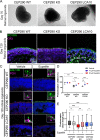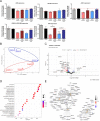This is a preprint.
Eupatilin improves cilia defects in human CEP290 ciliopathy models
- PMID: 37205323
- PMCID: PMC10187159
- DOI: 10.1101/2023.04.12.536565
Eupatilin improves cilia defects in human CEP290 ciliopathy models
Update in
-
Eupatilin Improves Cilia Defects in Human CEP290 Ciliopathy Models.Cells. 2023 Jun 7;12(12):1575. doi: 10.3390/cells12121575. Cells. 2023. PMID: 37371046 Free PMC article.
Abstract
The photoreceptor outer segment is a highly specialized primary cilium essential for phototransduction and vision. Biallelic pathogenic variants in the cilia-associated gene CEP290 cause non-syndromic Leber congenital amaurosis 10 (LCA10) and syndromic diseases, where the retina is also affected. While RNA antisense oligonucleotides and gene editing are potential treatment options for the common deep intronic variant c.2991+1655A>G in CEP290 , there is a need for variant-independent approaches that could be applied to a broader spectrum of ciliopathies. Here, we generated several distinct human models of CEP290 -related retinal disease and investigated the effects of the flavonoid eupatilin as a potential treatment. Eupatilin improved cilium formation and length in CEP290 LCA10 patient-derived fibroblasts, in gene-edited CEP290 knockout (CEP290 KO) RPE1 cells, and in both CEP290 LCA10 and CEP290 KO iPSCs-derived retinal organoids. Furthermore, eupatilin reduced rhodopsin retention in the outer nuclear layer of CEP290 LCA10 retinal organoids. Eupatilin altered gene transcription in retinal organoids, by modulating the expression of rhodopsin, and by targeting cilia and synaptic plasticity pathways. This work sheds light into the mechanism of action of eupatilin, and supports its potential as a variant-independent approach for CEP290 -associated ciliopathies.
Figures





References
-
- Sayer J.A., Otto E.A., O’Toole J.F., Nurnberg G., Kennedy M.A., Becker C., Hennies H.C., Helou J., Attanasio M., Fausett B. v., et al. (2006) The centrosomal protein nephrocystin-6 is mutated in Joubert syndrome and activates transcription factor ATF4. Nat Genet, 38, 674–681. - PubMed
-
- Valente E.M., Silhavy J.L., Brancati F., Barrano G., Krishnaswami S.R., Castori M., Lancaster M.A., Boltshauser E., Boccone L., Al-Gazali L., et al. (2006) Mutations in CEP290, which encodes a centrosomal protein, cause pleiotropic forms of Joubert syndrome. Nat Genet, 38, 623–625. - PubMed
-
- Coppieters F., Lefever S., Leroy B.P. and de Baere E. (2010) CEP290, a gene with many faces: mutation overview and presentation of CEP290base. Hum Mutat, 31, 1097–1108. - PubMed
Publication types
Grants and funding
LinkOut - more resources
Full Text Sources
Research Materials
